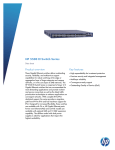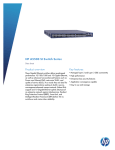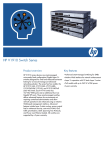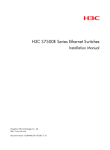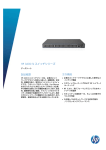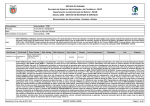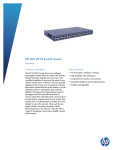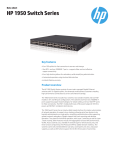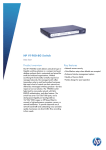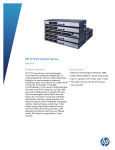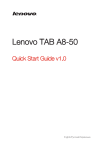Download Hewlett Packard Enterprise A 5500-24G EI
Transcript
HP A5500 EI Switch Series Data sheet Product overview Key features These Gigabit Ethernet switches deliver outstanding security, reliability, and multiservice support capabilities for robust switching at the edge or aggregation layer of large enterprise and campus networks or in the core layer of SMB networks. The HP A5500 EI Switch Series is comprised of Layer 2/3 Gigabit Ethernet switches that can accommodate the most demanding applications and provide resilient and secure connectivity as well as the latest traffic prioritization technologies to enhance applications on convergent networks. With complete IPv4/IPv6 dual stack support, the series provides investment protection with an easy transition from IPv4 to IPv6 networks. Designed for increased flexibility, these switches are available with 24 or 48 Gigabit Ethernet ports. Power over Ethernet (PoE) and non-PoE models are available with optional GbE and 10 GbE expansion capability. The all-fiber model with dual power supplies is ideal for applications that require the highest availability. b High expandability for investment protection b Premium security and integrated management b Multilayer reliability b Convergence-ready support b Outstanding quality of service (QoS) Features and benefits Quality of Service (QoS) • Storm restraint: allows limitation of broadcast, multicast, and unknown unicast traffic rate to cut down on unwanted broadcast traffic on the network • Advanced classifier-based QoS: classifies traffic using multiple match criteria based on Layer 2, 3, and 4 information; applies QoS policies such as setting priority level and rate limit to bi-directional selected traffic on a per-port, per-VLAN, or whole switch basis • Powerful QoS feature: creates traffic classes based on ACLs, IEEE 802.1p precedence, IP, DSCP or ToS precedence; supports filter, redirect, mirror, or remark; supports the following congestion actions: strict priority queuing (SP), weighted round robin (WRR), SP+WRR, weighted fair queuing (WFQ), and weighted random early discard (WRED) • Traffic policing: supports Committed Access Rate (CAR) and line rate Management • Friendly port names: allow assignment of descriptive names to ports • Remote configuration and management: is available through a secure Web browser or a command-line interface (CLI) • Manager and operator privilege levels: enable read-only (operator) and read-write (manager) access on CLI and Web browser management interfaces • Command authorization: leverages HWTACACS to link a custom list of CLI commands to an individual network administrator's login; also provides an audit trail • Secure Web GUI: provides a secure, easy-to-use graphical interface for configuring the module via HTTPS • Dual flash images: provide independent primary and secondary operating system files for backup while upgrading • Multiple configuration files: can be stored to the flash image • Complete session logging: provides detailed information for problem identification and resolution • SNMPv1, v2c, and v3: facilitate centralized discovery, monitoring, and secure management of networking devices • Remote monitoring (RMON): uses standard SNMP to monitor essential network functions; supports events, alarm, history, and statistics group plus a private alarm extension group • IEEE 802.1AB Link Layer Discovery Protocol (LLDP): automated device discovery protocol provides easy mapping by network management applications • sFlow (RFC 3176): provides scalable, ASIC-based wire-speed network monitoring and accounting with no impact on network performance; this allows network operators to gather a variety of sophisticated network statistics and information for capacity planning and real-time network monitoring purposes • Management VLAN: segments traffic to and from management interfaces, including CLI/telnet, a Web browser interface, and SNMP • Remote Intelligent Mirroring: mirrors ingress/egress ACL-selected traffic from a switch port or VLAN to a local or remote switch port anywhere on the network • Device Link Detection Protocol (DLDP): monitors cable between two switches and shuts down the ports on both ends if the cable is broken, preventing network problems such as loops • IPv6 management: future-proofs networking, as the switch is capable of being managed whether the attached network is running IPv4 or IPv6; supports pingv6, tracertv6, Telnetv6, TFTPv6, DNSv6, syslogv6, FTPv6, SNMPv6, DHCPv6, and RADIUS for IPv6 • Troubleshooting: ingress and egress port monitoring enable network problem solving; virtual cable tests provide visibility into cable problems • in-service software upgrade (ISSU): enables operators to perform upgrades in the shortest possible amount of time with minimal risk to network operations or traffic disruptions Connectivity • Auto-MDIX: automatically adjusts for straight-through or crossover cables on all 10/100/1000 ports • Flow control: using standard IEEE 802.3x, it provides back pressure to reduce congestion in heavy traffic situations • Jumbo packet support: supports up to 9216-byte frame size to improve performance of large data transfers 2 • Optional 10 Gigabit Ethernet ports: allow the addition of 10 Gigabit Ethernet connections for uplinks or high-bandwidth server connections; flexibly supports XFP, SFP+, or CX4 local connections • High-density port connectivity: provides up to 48 fixed 10/100/1000BASE-T or 24 SFP 100/1000BASE-X ports in a Layer 2/Layer 3 stackable switch supporting unique IRF stacking • IEEE 802.3af Power over Ethernet (PoE) support: simplifies deployment and dramatically reduces installation costs by helping to eliminate the time and cost involved in supplying local power at each access point location • Ethernet OAM: provides a Layer 2 link performance and fault detection monitoring tool, which reduces failover and network convergence times • High-bandwidth CX4 and SFP+ local stacking: provide 10 Gbps SPF+ or 12 Gbps CX4 local stacking cables; achieve a resilient stacking configuration Performance • Nonblocking architecture: up to 192 Gbps nonblocking switching fabric provides wire-speed switching with up to 143 million pps throughput • Hardware-based wire-speed access control lists (ACLs): feature-rich ACL implementation (TCAM based) helps ensure high levels of security and ease of administration without impacting network performance Resiliency and high availability • Separate data and control paths: keeps control separated from services and keeps service processing isolated; increases security and performance • External redundant power supply: provides high reliability • Smart link: allows 50 ms failover between links • Spanning Tree/MSTP, RSTP: provides redundant links while preventing network loops • Rapid Ring Protection Protocol (RRPP): connects multiple switches in a high-performance ring using standard Ethernet technology; traffic can be rerouted around the ring in less than 50 ms, reducing the impact on traffic and applications • Virtual Router Redundancy Protocol (VRRP) : allows a group of routers to dynamically back each other up to create highly available routed environments, • Intelligent Resilient Framework (IRF): creates virtual resilient switching fabrics, where two or more switches perform as a single Layer 2 switch, Layer 3 router; switches do not have to be co-located and can be part of a disaster recovery system; servers or switches can be attached using standard LACP for automatic load-balancing and high availability; simplifies network operation by eliminating the complexity of Spanning Tree, Equal-Cost Multipath (ECMP), or VRRP • IP Fast Reroute (FRR): forms backup paths and allows 50 ms switchover in case of a main path fault Layer 2 switching • 32K MAC addresses: provide access to many Layer 2 devices • IEEE 802.1ad QinQ and Selective QinQ: increase the scalability of an Ethernet network by providing a hierarchical structure; connect multiple LANs on a high-speed campus or metro network • GARP VLAN Registration Protocol (GVRP): allows automatic learning and dynamic assignment of VLANs • IEEE 802.1ad QinQ: increases the scalability of an Ethernet network by providing a hierarchical structure; connects multiple LANs on a high-speed campus or metro network • 10 GbE port aggregation: allows grouping of ports to increase overall data throughput to a remote device • IGMP and MLD snooping: effectively control and manage the flooding of multicast packets in a Layer 2 network Layer 3 services • Address Resolution Protocol (ARP): determines the MAC address of another IP host in the same subnet • Dynamic Host Configuration Protocol (DHCP): simplifies the management of large IP networks and supports client and server; DHCP Relay enables DHCP operation across subnets • Loopback interface address: defines an address in Routing Information Protocol (RIP) and OSPF that can always be reachable, improving diagnostic capability • User Datagram Protocol (UDP) helper function: allows UDP broadcasts to be directed across router interfaces to specific IP unicast or subnet broadcast addresses and prevents server spoofing for UDP services such as DHCP 3 • Route maps: provide more control during route redistribution; allow filtering and altering of route metrics Layer 3 routing • IPv4 routing protocols: support static routes, RIP, OSPF, ISIS, and BGP • IPv6 routing protocols: provide routing of IPv6 at wire speed; support static routes, RIPng, OSPFv3, IS-ISv6, and BGP4+ for IPv6 • Equal-Cost Multipath (ECMP): enables multiple equal-cost links in a routing environment to increase link redundancy and scale bandwidth • Policy-based routing: makes routing decisions based on policies set by the network administrator • Secure management access: securely encrypts all access methods (CLI, GUI, or MIB) through SSHv2, SSL, and/or SNMPv3 • Secure File Transfer Protocol (FTP): allows secure file transfer to and from the switch; protects against unwanted file downloads or unauthorized copying of switch configuration file • Guest VLAN: similar to IEEE 802.1X, it provides a browser-based environment to authenticated clients • Endpoint Admission Defense (EAD): provides security policies to users accessing a network • Port security: allows access only to specified MAC addresses, which can be learned or specified by the administrator • IGMPv1, v2, and v3: allow individual hosts to be registered on a particular VLAN • Port isolation: secures and adds privacy, and prevents malicious attackers from obtaining user information • PIM-SSM, PIM-DM, and PIM-SM (for IPv4 and IPv6): support IP Multicast address management and inhibition of DoS attacks • STP BPDU port protection: blocks Bridge Protocol Data Units (BPDUs) on ports that do not require BPDUs, preventing forged BPDU attacks • IPv6 tunneling: allows a smooth transition from IPv4 to IPv6 by encapsulating IPv6 traffic over an existing IPv4 infrastructure • STP Root Guard: protects root bridge from malicious attack or configuration mistakes • Unicast Reverse Path Forwarding (uRPF): is defined by RFC 3704 and limits erroneous or malicious traffic • Bidirectional Forwarding Detection (BFD): enables link connectivity monitoring and reduces network convergence time for RIP, OSPF, BGP, IS-IS, VRRP, and IRF • DHCP protection: blocks DHCP packets from unauthorized DHCP servers, preventing denial-of-service attacks • Dynamic ARP protection: blocks ARP broadcasts from unauthorized hosts, preventing eavesdropping or theft of network data • IP source guard: helps prevent IP spoofing attacks Security • RADIUS/HWTACACS: eases switch management security administration by using a password • Access control lists (ACLs): provide IP Layer 2 to authentication server Layer 4 traffic filtering; support global ACL, VLAN ACL, port ACL, and IPv6 ACL • Multiple Customer Edge (MCE): facilitates • IEEE 802.1X: industry-standard method of user authentication using an IEEE 802.1X supplicant on the client in conjunction with a RADIUS server • MAC-based authentication: authenticates the client with the RADIUS server based on the client's MAC address • Identity-driven security and access control: MPLS VPN network integration with up to 64 VPNs support • Unicast Reverse Path Forwarding (URPF): allows normal packets to be forwarded correctly, whereas the attaching packet will be discarded due to lack of reverse path route or incorrect inbound interface; prevents source spoofing and distributed attacks; supports distributed URPF – Per-user ACLs: permit or deny user access to specific network resources based on user identity and time of day, allowing multiple types of users on the same network to access specific network services without risk to network security or unauthorized access to sensitive data – Automatic VLAN assignment: automatically assigns users to the appropriate VLAN based on their identities 4 Convergence Device support • IEEE 802.1AB Link Layer Discovery Protocol (LLDP): is an automated device discovery protocol for easy mapping by network management applications • Cisco prestandard PoE support: detects and provides power to Cisco's prestandard PoE devices such as wireless LAN access points and IP phones • LLDP-MED: is a standard extension that automatically configures network devices, including LLDP-capable IP phones • LLDP-CDP compatibility: receives and recognizes CDP packets from Cisco's IP phones for seamless interoperation • IEEE 802.3af Power over Ethernet: provides up to 15.4 W per port to PoE-powered devices such as IP phones, wireless access points, and video cameras • PoE allocations: support multiple methods (automatic, IEEE 802.3af class, LLDP-MED, or user specified) to allocate PoE power for more efficient energy savings • Voice VLAN: automatically assigns VLAN and priority for IP phones, simplifying network configuration and maintenance • IP multicast snooping (data-driven IGMP): automatically prevents flooding of IP multicast traffic • Internet Group Management Protocol (IGMP): is used by IP hosts to establish and maintain multicast groups; supports v1, v2, and v3; utilizes Any-Source Multicast (ASM) or Source-Specific Multicast (SSM) to manage IPv4 multicast networks Additional information • Green IT and power: use the latest advances in silicon development, shut off unused ports, and use variable-speed fans to improve power efficiency • Green initiative support: provides support for RoHS and WEEE regulations Warranty and support • Lifetime warranty: for as long as you own the product with advance replacement and next-business-day delivery (available in most countries)* • Electronic and telephone support: limited electronic and telephone support is available from HP; refer to www.hp.com/networking/warranty for details on the support provided and the period during which support is available • Software releases: refer to www.hp.com/networking/warranty for details on the software releases provided and the period during which software releases are available for your product(s) • Protocol Independent Multicast (PIM): is used for IPv4 and IPv6 multicast applications; supports PIM dense mode (DM), sparse mode (SM), and source-specific mode (SSM) • Multicast Source Discovery Protocol (MSDP): is used for inter-domain multicast applications, allowing multiple PIM-SM domains to interoperate • Multicast Border Gateway Protocol (MBGP): allows multicast traffic to be forwarded across BGP networks, separate from unicast traffic • Multicast VLAN: allows multiple VLANs to receive the same IPv4 or IPv6 multicast traffic, reducing network bandwidth demand by eliminating multiple streams to each VLAN *Hardware warranty replacement for as long as you own the product, with next business day advance replacement (available in most countries) with a five-year hardware warranty replacement for the disk drive included with HP AllianceONE Services zl Module, HP Threat Management Services zl Module, HP PCM+ Agent with AllianceONE Services zl Module, and HP E-MSM765 zl Mobility Controller. For details, refer to the HP Software License, Warranty, and Support booklet at www.hp.com/networking/warranty. 5 HP A5500 EI Switch Series Specifications HP A5500-24G EI Switch with 2 Interface Slots (JD377A) HP A5500-24G DC EI Switch (JD373A) HP A5500-24G-PoE EI Switch (JD378A) 24 RJ-45 autosensing 10/100/1000 ports (IEEE 802.3 Type 10BASE-T, IEEE 802.3u Type 100BASE-TX, IEEE 802.3ab Type 1000BASE-T); Media Type: Auto-MDIX; Duplex: 10BASE-T/100BASE-TX: half or full; 1000BASE-T: full only 24 RJ-45 autosensing 10/100/1000 ports (IEEE 802.3 Type 10BASE-T, IEEE 802.3u Type 100BASE-TX, IEEE 802.3ab Type 1000BASE-T); Media Type: Auto-MDIX; Duplex: 10BASE-T/100BASE-TX: half or full; 1000BASE-T: full only 24 RJ-45 autosensing 10/100/1000 PoE ports (IEEE 802.3 Type 10BASE-T, IEEE 802.3u Type 100BASE-TX, IEEE 802.3ab Type 1000BASE-T, IEEE 802.3af PoE); Media Type: Auto-MDIX; Duplex: 10BASE-T/100BASE-TX: half or full; 1000BASE-T: full only 4 dual-personality ports; auto-sensing 10/100/1000Base-T or SFP 4 dual-personality ports; auto-sensing 10/100/1000Base-T or SFP 4 dual-personality ports; auto-sensing 10/100/1000Base-T or SFP 2 port expansion module slots 2 port expansion module slots 2 port expansion module slots 1 RJ-45 serial console port 1 RJ-45 serial console port 1 RJ-45 serial console port Supports a maximum of 24 autosensing 10/100/1000 ports Supports a maximum of 24 autosensing 10/100/1000 ports Supports a maximum of 24 autosensing 10/100/1000 ports 11.81(d) x 17.32(w) x 1.72(h) in. (30 x 44 x 4.36 cm) (1U height) 11.81(d) x 17.32(w) x 1.72(h) in. (30 x 44 x 4.36 cm) (1U height) 16.54(d) x 17.32(w) x 1.72(h) in. (42 x 44 x 4.36 cm) (1U height) 8.82 lb. (4 kg) 8.82 lb. (4 kg) 13.23 lb. (6 kg) 256 MB SDRAM, 32 MB flash; packet buffer size: 2 MB 256 MB SDRAM, 32 MB flash; packet buffer size: 2 MB 256 MB SDRAM, 32 MB flash; packet buffer size: 2 MB Mounts in an EIA standard 19-in. telco rack or equipment cabinet (hardware included) Mounts in an EIA standard 19-in. telco rack or equipment cabinet (hardware included) Mounts in an EIA standard 19-in. telco rack or equipment cabinet (hardware included) Performance 1000 Mb Latency < 3.2 µs < 3.2 µs < 3.2 µs 10 Gbps Latency < 2.6 µs < 2.6 µs < 2.6 µs Throughput 107.2 million pps 107.2 million pps 107.2 million pps Routing/Switching capacity 144 Gbps 144 Gbps 144 Gbps Routing table size 12000 entries 12000 entries 12000 entries Environment Operating temperature 32°F to 113°F (0°C to 45°C) 32°F to 113°F (0°C to 45°C) 32°F to 113°F (0°C to 45°C) Operating relative humidity 10% to 90%, noncondensing 10% to 90%, noncondensing 10% to 90%, noncondensing Nonoperating/Storage temperature -40°F to 158°F (-40°C to 70°C) -40°F to 158°F (-40°C to 70°C) -40°F to 158°F (-40°C to 70°C) Nonoperating/Storage relative humidity 5% to 95%, noncondensing 5% to 95%, noncondensing 5% to 95%, noncondensing Electrical characteristics Maximum heat dissipation 375 BTU/hr (395.63 kJ/hr) 358 BTU/hr (377.69 kJ/hr) 700 BTU/hr (738.5 kJ/hr) Voltage 100-240 VAC Ports Physical characteristics Dimensions Weight Memory and processor Mounting DC voltage 100-240 VAC -48 to -60 VDC -52 to -55 VDC 110 W 105 W 575 W Frequency 50 / 60 Hz 50 / 60 Hz 50 / 60 Hz Notes Maximum power rating and maximum heat dissipation are the worst-case theoretical maximum numbers provided for planning the infrastructure with fully loaded PoE (if equipped), 100% traffic, all ports plugged in, and all modules populated. Maximum power rating and maximum heat dissipation are the worst-case theoretical maximum numbers provided for planning the infrastructure with fully loaded PoE (if equipped), 100% traffic, all ports plugged in, and all modules populated. Maximum power rating and maximum heat dissipation are the worst-case theoretical maximum numbers provided for planning the infrastructure with fully loaded PoE (if equipped), 100% traffic, all ports plugged in, and all modules populated. PoE power is the power supplied by the internal power supply. It is dependent on the type and quantity of power supplies and may be supplemented with the use of an external power supply (EPS). With DC input, the maximum power consumption is 485 W (370 W for PoE). Safety UL 60950-1; EN 60825-1 Safety of Laser Products-Part 1; EN 60825-2 Safety of Laser Products-Part 2; IEC 60950-1; CAN/CSA-C22.2 No. 60950-1; EN 60950-1/A11; FDA 21 CFR Subchapter J; ROHS Compliance UL 60950-1; EN 60825-1 Safety of Laser Products-Part 1; EN 60825-2 Safety of Laser Products-Part 2; IEC 60950-1; CAN/CSA-C22.2 No. 60950-1; EN 60950-1/A11; FDA 21 CFR Subchapter J; ROHS Compliance UL 60950-1; EN 60825-1 Safety of Laser Products-Part 1; EN 60825-2 Safety of Laser Products-Part 2; IEC 60950-1; CAN/CSA-C22.2 No. 60950-1; EN 60950-1/A11; FDA 21 CFR Subchapter J; ROHS Compliance Maximum power rating PoE power 370 W 6 HP A5500 EI Switch Series Specifications (continued) HP A5500-24G EI Switch with 2 Interface Slots (JD377A) HP A5500-24G DC EI Switch (JD373A) HP A5500-24G-PoE EI Switch (JD378A) Emissions FCC part 15 Class A; VCCI Class A; EN 55022 Class A; CISPR 22 Class A; ICES-003 Class A; ANSI C63.4 2003; ETSI EN 300 386 V1.3.3; AS/NZS CISPR22 Class A; EN 61000-3-2; EN 61000-3-3; EN 61000-4-2; EN 61000-4-3; EN 61000-4-4; EN 61000-4-5; EN 61000-4-6; EN 61000-4-11; EN 61000-3-2:2006; EN 61000-3-3:1995 +A1:2001+A2:2005; EMC Directive 2004/108/EC; FCC (CFR 47, Part 15) Class A FCC part 15 Class A; VCCI Class A; EN 55022 Class A; CISPR 22 Class A; ICES-003 Class A; ANSI C63.4 2003; ETSI EN 300 386 V1.3.3; AS/NZS CISPR22 Class A; EN 61000-3-2; EN 61000-3-3; EN 61000-4-2; EN 61000-4-3; EN 61000-4-4; EN 61000-4-5; EN 61000-4-6; EN 61000-4-11; EN 61000-3-2:2006; EN 61000-3-3:1995 +A1:2001+A2:2005; EMC Directive 2004/108/EC; FCC (CFR 47, Part 15) Class A FCC part 15 Class A; VCCI Class A; EN 55022 Class A; CISPR 22 Class A; ICES-003 Class A; ANSI C63.4 2003; ETSI EN 300 386 V1.3.3; AS/NZS CISPR22 Class A; EN 61000-3-2; EN 61000-3-3; EN 61000-4-2; EN 61000-4-3; EN 61000-4-4; EN 61000-4-5; EN 61000-4-6; EN 61000-4-11; EN 61000-3-2:2006; EN 61000-3-3:1995 +A1:2001+A2:2005; EMC Directive 2004/108/EC; FCC (CFR 47, Part 15) Class A Management IMC - Intelligent Management Center; command-line interface; Web browser; SNMP Manager; IEEE 802.3 Ethernet MIB IMC - Intelligent Management Center; command-line interface; Web browser; SNMP Manager; IEEE 802.3 Ethernet MIB IMC - Intelligent Management Center; command-line interface; Web browser; SNMP Manager; IEEE 802.3 Ethernet MIB Services 3-year, 4-hour onsite, 13x5 coverage for hardware (UV870E) 3-year, 4-hour onsite, 24x7 coverage for hardware (UV873E) 3-year, 4-hour onsite, 24x7 coverage for hardware, 24x7 software phone support (UV876E) 3-year, 24x7 SW phone support, software updates (UV879E) Installation with minimum configuration, system-based pricing (UW451E) 4-year, 4-hour onsite, 13x5 coverage for hardware (UV871E) 4-year, 4-hour onsite, 24x7 coverage for hardware (UV874E) 4-year, 4-hour onsite, 24x7 coverage for hardware, 24x7 software phone (UV877E) 4-year, 24x7 SW phone support, software updates (UV880E) 5-year, 4-hour onsite, 13x5 coverage for hardware (UV872E) 5-year, 4-hour onsite, 24x7 coverage for hardware (UV875E) 5-year, 4-hour onsite, 24x7 coverage for hardware, 24x7 software phone (UV878E) 5-year, 24x7 SW phone support, software updates (UV881E) 3 Yr 6 hr Call-to-Repair Onsite (UW966E) 4 Yr 6 hr Call-to-Repair Onsite (UW967E) 5 Yr 6 hr Call-to-Repair Onsite (UW968E) 3-year, 4-hour onsite, 13x5 coverage for hardware (UV870E) 3-year, 4-hour onsite, 24x7 coverage for hardware (UV873E) 3-year, 4-hour onsite, 24x7 coverage for hardware, 24x7 software phone support (UV876E) 3-year, 24x7 SW phone support, software updates (UV879E) Installation with minimum configuration, system-based pricing (UW451E) 4-year, 4-hour onsite, 13x5 coverage for hardware (UV871E) 4-year, 4-hour onsite, 24x7 coverage for hardware (UV874E) 4-year, 4-hour onsite, 24x7 coverage for hardware, 24x7 software phone (UV877E) 4-year, 24x7 SW phone support, software updates (UV880E) 5-year, 4-hour onsite, 13x5 coverage for hardware (UV872E) 5-year, 4-hour onsite, 24x7 coverage for hardware (UV875E) 5-year, 4-hour onsite, 24x7 coverage for hardware, 24x7 software phone (UV878E) 5-year, 24x7 SW phone support, software updates (UV881E) 3 Yr 6 hr Call-to-Repair Onsite (UW966E) 4 Yr 6 hr Call-to-Repair Onsite (UW967E) 5 Yr 6 hr Call-to-Repair Onsite (UW968E) 3-year, 4-hour onsite, 13x5 coverage for hardware (UV870E) 3-year, 4-hour onsite, 24x7 coverage for hardware (UV873E) 3-year, 4-hour onsite, 24x7 coverage for hardware, 24x7 software phone support (UV876E) 3-year, 24x7 SW phone support, software updates (UV879E) 4-year, 4-hour onsite, 13x5 coverage for hardware (UV871E) 4-year, 4-hour onsite, 24x7 coverage for hardware (UV874E) 4-year, 4-hour onsite, 24x7 coverage for hardware, 24x7 software phone (UV877E) 4-year, 24x7 SW phone support, software updates (UV880E) 5-year, 4-hour onsite, 13x5 coverage for hardware (UV872E) 5-year, 4-hour onsite, 24x7 coverage for hardware (UV875E) 5-year, 4-hour onsite, 24x7 coverage for hardware, 24x7 software phone (UV878E) 5-year, 24x7 SW phone support, software updates (UV881E) 3 Yr 6 hr Call-to-Repair Onsite (UW966E) 4 Yr 6 hr Call-to-Repair Onsite (UW967E) 5 Yr 6 hr Call-to-Repair Onsite (UW968E) Refer to the HP website at www.hp.com/networking/services for details on the service-level descriptions and product numbers. For details about services and response times in your area, please contact your local HP sales office. Refer to the HP website at www.hp.com/networking/services for details on the service-level descriptions and product numbers. For details about services and response times in your area, please contact your local HP sales office. Refer to the HP website at www.hp.com/networking/services for details on the service-level descriptions and product numbers. For details about services and response times in your area, please contact your local HP sales office. 7 HP A5500 EI Switch Series Specifications (continued) Standards and protocols (applies to all products in series) HP A5500-24G EI Switch with 2 Interface Slots (JD377A) HP A5500-24G DC EI Switch (JD373A) HP A5500-24G-PoE EI Switch (JD378A) BGP RFC 1657 Definitions of Managed Objects for BGPv4 RFC 1771 BGPv4 RFC 2858 BGP-4 Multi-Protocol Extensions (VACM) for the Simple Network Management Protocol (SNMP) RFC 3417 Transport Mappings for the Simple Network Management Protocol (SNMP) RFC 3484 Default Address Selection for Internet Protocol version 6 (IPv6) RFC 3493 Basic Socket Interface Extensions for IPv6 RFC 3542 Advanced Sockets Application Program Interface (API) for IPv6 RFC 3587 IPv6 Global Unicast Address Format RFC 3596 DNS Extensions to Support IP Version 6 RFC 3623 Graceful OSPF Restart RFC 3704 Unicast Reverse Path Forwarding (URPF) RFC 3768 VRRP RFC 3810 Multicast Listener Discovery Version 2 (MLDv2) for IPv6 RFC 4113 Management Information Base for the User Datagram Protocol (UDP) RFC 4213 Basic IPv6 Transition Mechanisms RFC 4443 Internet Control Message Protocol (ICMPv6) for the Internet Protocol Version 6 (IPv6) Specification 802.1r - GARP Proprietary Attribute Registration Protocol (GPRP) RFC 4113 MIB for UDP RFC 4443 ICMPv6 Device management RFC 1157 SNMPv1/v2c RFC 1305 NTPv3 RFC 1901 (Community based SNMPv2) RFC 2452 MIB for TCP6 RFC 2454 MIB for UDP6 RFC 2573 (SNMPv3 Applications) RFC 2576 (Coexistence between SNMP V1, V2, V3) RFC 2819 RMON RFC 3410 (Management Framework) RFC 3416 (SNMP Protocol Operations v2) RFC 3417 (SNMP Transport Mappings) HTML and telnet management Multiple Configuration Files SNMP v3 and RMON RFC support SSHv1/SSHv2 Secure Shell General protocols IEEE 802.1ad Q-in-Q IEEE 802.1D MAC Bridges IEEE 802.1p Priority IEEE 802.1Q (GVRP) IEEE 802.1w Rapid Reconfiguration of Spanning Tree IEEE 802.3ab 1000BASE-T IEEE 802.3ad Link Aggregation (LAG) IEEE 802.3ae 10-Gigabit Ethernet IEEE 802.3af Power over Ethernet IEEE 802.3i 10BASE-T IEEE 802.3u 100BASE-X IEEE 802.3x Flow Control IEEE 802.3z 1000BASE-X RFC 768 UDP RFC 791 IP RFC 792 ICMP RFC 793 TCP RFC 854 TELNET RFC 925 Multi-LAN Address Resolution RFC 950 Internet Standard Subnetting Procedure RFC 951 BOOTP RFC 1058 RIPv1 RFC 1122 Host Requirements RFC 1141 Incremental updating of the Internet checksum RFC 1213 Management Information Base for Network Management of TCP/IP-based internets RFC 1305 NTPv3 RFC 1350 TFTP Protocol (revision 2) RFC 1519 CIDR RFC 1542 BOOTP Extensions RFC 1723 RIP v2 RFC 1812 IPv4 Routing RFC 1887 An Architecture for IPv6 Unicast Address Allocation RFC 2131 DHCP RFC 2236 IGMP Snooping RFC 2338 VRRP RFC 2375 IPv6 Multicast Address Assignments RFC 2616 HTTP Compatibility v1.1 RFC 2644 Directed Broadcast Control RFC 2865 Remote Authentication Dial In User Service (RADIUS) RFC 2866 RADIUS Accounting RFC 3246 Expedited Forwarding PHB RFC 3410 Applicability Statements for SNMP RFC 3414 User-based Security Model (USM) for version 3 of the Simple Network Management Protocol (SNMPv3) RFC 3415 View-based Access Control Model IP multicast RFC 2236 IGMPv2 RFC 2710 Multicast Listener Discovery (MLD) for IPv6 RFC 2858 Multiprotocol Extensions for BGP-4 RFC 3376 IGMPv3 RFC 3569 An Overview of Source-Specific Multicast (SSM) RFC 3618 Multicast Source Discovery Protocol (MSDP) RFC 3973 PIM Dense Mode IPv6 RFC 1881 IPv6 Address Allocation Management RFC 1887 IPv6 Unicast Address Allocation Architecture RFC 1981 IPv6 Path MTU Discovery RFC 2080 RIPng for IPv6 RFC 2373 IPv6 Addressing Architecture RFC 2375 IPv6 Multicast Address Assignments RFC 2460 IPv6 Specification RFC 2461 IPv6 Neighbor Discovery RFC 2462 IPv6 Stateless Address Auto-configuration RFC 2463 ICMPv6 RFC 2464 Transmission of IPv6 over Ethernet Networks RFC 2475 IPv6 DiffServ Architecture RFC 2710 Multicast Listener Discovery (MLD) for IPv6 RFC 2740 OSPFv3 for IPv6 RFC 2893 Transition Mechanisms for IPv6 Hosts and Routers RFC 2925 Definitions of Managed Objects for Remote Ping, Traceroute, and Lookup Operations (Ping only) RFC 2925 Remote Operations MIB (Ping only) RFC 3056 Connection of IPv6 Domains via IPv4 Clouds RFC 3162 RADIUS and IPv6 RFC 3306 Unicast-Prefix-based IPv6 Multicast Addresses RFC 3307 IPv6 Multicast Address Allocation RFC 3315 DHCPv6 (client and relay) RFC 3484 Default Address Selection for IPv6 RFC 3493 Basic Socket Interface Extensions for IPv6 RFC 3513 IPv6 Addressing Architecture RFC 3542 Advanced Sockets API for IPv6 RFC 3587 IPv6 Global Unicast Address Format RFC 3596 DNS Extension for IPv6 RFC 3810 MLDv2 for IPv6 MIBs RFC 1212 RFC 1213 RFC 1657 RFC 1724 RFC 1757 RFC 1850 RFC 2012 RFC 2013 RFC 2233 RFC 2452 RFC 2454 RFC 2465 RFC 2466 RFC 2571 RFC 2572 RFC 2573 RFC 2574 RFC 2618 RFC 2620 RFC 2787 RFC 2819 RFC 2925 RFC 3414 RFC 3415 RFC 4113 Concise MIB Definitions MIB II BGP-4 MIB RIPv2 MIB Remote Network Monitoring MIB OSPFv2 MIB SNMPv2 MIB for TCP SNMPv2 MIB for UDP Interface MIB IPV6-TCP-MIB IPV6-UDP-MIB IPv6 MIB ICMPv6 MIB SNMP Framework MIB SNMP-MPD MIB SNMP-Target MIB SNMP USM MIB RADIUS Authentication Client MIB RADIUS Accounting Client MIB VRRP MIB RMON MIB Ping MIB SNMP-User based-SM MIB SNMP-View based-ACM MIB UDP MIB Network management IEEE 802.1AB Link Layer Discovery Protocol (LLDP) IEEE 802.1D (STP) RFC 1157 SNMPv1 RFC 1212 Concise MIB definitions RFC 1215 SNMP Generic traps RFC 1757 RMON 4 groups: Stats, History, Alarms and Events RFC 1901 SNMPv2 Introduction RFC 1918 Private Internet Address Allocation RFC 2373 Remote Network Monitoring Management Information Base for High Capacity Networks RFC 2571 An Architecture for Describing SNMP Management Frameworks RFC 2572 Message Processing and Dispatching for the Simple Network Management Protocol (SNMP) RFC 2573 SNMP Applications RFC 2574 SNMPv3 User-based Security Model (USM) RFC 2575 SNMPv3 View-based Access Control Model (VACM) RFC 2576 Coexistence between SNMP versions RFC 2578 SMIv2 RFC 2581 TCP6 RFC 2819 Four groups of RMON: 1 (statistics), 2 (history), 3 (alarm) and 9 (events) RFC 2925 Definitions of Managed Objects for Remote Ping, Traceroute, and Lookup Operations RFC 3176 sFlow RFC 3410 Introduction to Version 3 of the Internet-standard Network Management Framework RFC 3414 SNMPv3 User-based Security Model (USM) RFC 3415 SNMPv3 View-based Access Control Model VACM) ANSI/TIA-1057 LLDP Media Endpoint Discovery (LLDP-MED) SNMPv1/v2c/v3 OSPF RFC 1587 OSPF NSSA RFC 1850 OSPFv2 Management Information Base (MIB), traps RFC 2328 OSPFv2 8 HP A5500 EI Switch Series Specifications (continued) HP A5500-24G EI Switch with 2 Interface Slots (JD377A) Standards and protocols (applies to all products in series) QoS/CoS IEEE 802.1P (CoS) RFC 2474 DSCP DiffServ RFC 2475 DiffServ Architecture RFC 2597 DiffServ Assured Forwarding (AF) RFC 2598 DiffServ Expedited Forwarding (EF) HP A5500-24G DC EI Switch (JD373A) HP A5500-24G-PoE EI Switch (JD378A) Security IEEE 802.1X Port Based Network Access Control RFC 1492 TACACS+ RFC 1918 Address Allocation for Private Internets RFC 2865 RADIUS Authentication RFC 2866 RADIUS Accounting Access Control Lists (ACLs) MAC Authentication Port Security SSHv2 Secure Shell 9 HP A5500 EI Switch Series Specifications (continued) Ports HP A5500-48G EI Switch with 2 Interface Slots (JD375A) HP A5500-48G-PoE EI Switch (JD376A) 48 RJ-45 autosensing 10/100/1000 ports (IEEE 802.3 Type 10BASE-T, IEEE 802.3u Type 100BASE-TX, IEEE 802.3ab Type 1000BASE-T); Media Type: Auto-MDIX; Duplex: 10BASE-T/100BASE-TX: half or full; 1000BASE-T: full only 48 RJ-45 autosensing 10/100/1000 PoE ports (IEEE 802.3 Type 10BASE-T, IEEE 802.3u Type 100BASE-TX, IEEE 802.3ab Type 1000BASE-T, IEEE 802.3af PoE); Media Type: Auto-MDIX; Duplex: 10BASE-T/100BASE-TX: half or full; 1000BASE-T: full only 4 dual-personality ports; auto-sensing 10/100/1000Base-T or SFP 4 dual-personality ports; auto-sensing 10/100/1000Base-T or SFP 2 port expansion module slots 2 port expansion module slots 1 RJ-45 serial console port 1 RJ-45 serial console port Supports a maximum of 48 autosensing 10/100/1000 ports Supports a maximum of 48 autosensing 10/100/1000 ports Physical characteristics Dimensions 11.81(d) x 17.32(w) x 1.72(h) in. (30 x 44 x 4.36 cm) (1U height) 16.54(d) x 17.32(w) x 1.72(h) in. (42 x 44 x 4.36 cm) (1U height) Weight 9.92 lb. (4.5 kg) 14.33 lb. (6.5 kg) 256 MB SDRAM, 32 MB flash; packet buffer size: 4 MB 256 MB SDRAM, 32 MB flash; packet buffer size: 4 MB Mounts in an EIA standard 19-in. telco rack or equipment cabinet (hardware included) Mounts in an EIA standard 19-in. telco rack or equipment cabinet (hardware included) Performance 1000 Mb Latency < 3.2 µs < 3.2 µs 10 Gbps Latency < 2.6 µs < 2.6 µs Throughput 142.9 million pps 142.9 million pps Routing/Switching capacity 192 Gbps 192 Gbps Routing table size 12000 entries 12000 entries Environment Operating temperature 32°F to 113°F (0°C to 45°C) 32°F to 113°F (0°C to 45°C) Operating relative humidity 10% to 90%, noncondensing 10% to 90%, noncondensing Nonoperating/Storage temperature -40°F to 158°F (-40°C to 70°C) -40°F to 158°F (-40°C to 70°C) Nonoperating/Storage relative humidity 5% to 95%, noncondensing 5% to 95%, noncondensing Electrical characteristics Maximum heat dissipation 392 BTU/hr (413.56 kJ/hr) 921 BTU/hr (971.66 kJ/hr) Voltage 100-240 VAC 100-240 VAC Memory and processor Mounting DC voltage Maximum power rating -52 to -55 VDC 115 W PoE power 910 W 740 W Frequency 50 / 60 Hz 50 / 60 Hz Notes Maximum power rating and maximum heat dissipation are the worst-case theoretical maximum numbers provided for planning the infrastructure with fully loaded PoE (if equipped), 100% traffic, all ports plugged in, and all modules populated. Maximum power rating and maximum heat dissipation are the worst-case theoretical maximum numbers provided for planning the infrastructure with fully loaded PoE (if equipped), 100% traffic, all ports plugged in, and all modules populated. PoE power is the power supplied by the internal power supply. It is dependent on the type and quantity of power supplies and may be supplemented with the use of an external power supply (EPS). With AC input, the maximum power consumption is 640 W (370 W for PoE). Safety UL 60950-1; EN 60825-1 Safety of Laser Products-Part 1; EN 60825-2 Safety of Laser Products-Part 2; IEC 60950-1; CAN/CSA-C22.2 No. 60950-1; EN 60950-1/A11; FDA 21 CFR Subchapter J; ROHS Compliance UL 60950-1; EN 60825-1 Safety of Laser Products-Part 1; EN 60825-2 Safety of Laser Products-Part 2; IEC 60950-1; CAN/CSA-C22.2 No. 60950-1; EN 60950-1/A11; FDA 21 CFR Subchapter J; ROHS Compliance Emissions FCC part 15 Class A; VCCI Class A; EN 55022 Class A; CISPR 22 Class A; ICES-003 Class A; ANSI C63.4 2003; ETSI EN 300 386 V1.3.3; AS/NZS CISPR22 Class A; EN 61000-3-2; EN 61000-3-3; EN 61000-4-2; EN 61000-4-3; EN 61000-4-4; EN 61000-4-5; EN 61000-4-6; EN 61000-4-11; EN 61000-3-2:2006; EN 61000-3-3:1995 +A1:2001+A2:2005; EMC Directive 2004/108/EC; FCC (CFR 47, Part 15) Class A FCC part 15 Class A; VCCI Class A; EN 55022 Class A; CISPR 22 Class A; ICES-003 Class A; ANSI C63.4 2003; ETSI EN 300 386 V1.3.3; AS/NZS CISPR22 Class A; EN 61000-3-2; EN 61000-3-3; EN 61000-4-2; EN 61000-4-3; EN 61000-4-4; EN 61000-4-5; EN 61000-4-6; EN 61000-4-11; EN 61000-3-2:2006; EN 61000-3-3:1995 +A1:2001+A2:2005; EMC Directive 2004/108/EC; FCC (CFR 47, Part 15) Class A Management IMC - Intelligent Management Center; command-line interface; Web browser; SNMP Manager; IEEE 802.3 Ethernet MIB IMC - Intelligent Management Center; command-line interface; Web browser; SNMP Manager; IEEE 802.3 Ethernet MIB 10 HP A5500 EI Switch Series Specifications (continued) Services HP A5500-48G EI Switch with 2 Interface Slots (JD375A) HP A5500-48G-PoE EI Switch (JD376A) 3-year, 4-hour onsite, 13x5 coverage for hardware (UV870E) 3-year, 4-hour onsite, 24x7 coverage for hardware (UV873E) 3-year, 4-hour onsite, 24x7 coverage for hardware, 24x7 software phone support (UV876E) 3-year, 24x7 SW phone support, software updates (UV879E) Installation with minimum configuration, system-based pricing (UW451E) 4-year, 4-hour onsite, 13x5 coverage for hardware (UV871E) 4-year, 4-hour onsite, 24x7 coverage for hardware (UV874E) 4-year, 4-hour onsite, 24x7 coverage for hardware, 24x7 software phone (UV877E) 4-year, 24x7 SW phone support, software updates (UV880E) 5-year, 4-hour onsite, 13x5 coverage for hardware (UV872E) 5-year, 4-hour onsite, 24x7 coverage for hardware (UV875E) 5-year, 4-hour onsite, 24x7 coverage for hardware, 24x7 software phone (UV878E) 5-year, 24x7 SW phone support, software updates (UV881E) 3 Yr 6 hr Call-to-Repair Onsite (UW966E) 4 Yr 6 hr Call-to-Repair Onsite (UW967E) 5 Yr 6 hr Call-to-Repair Onsite (UW968E) 3-year, 4-hour onsite, 13x5 coverage for hardware (UV870E) 3-year, 4-hour onsite, 24x7 coverage for hardware (UV873E) 3-year, 4-hour onsite, 24x7 coverage for hardware, 24x7 software phone support (UV876E) 3-year, 24x7 SW phone support, software updates (UV879E) 4-year, 4-hour onsite, 13x5 coverage for hardware (UV871E) 4-year, 4-hour onsite, 24x7 coverage for hardware (UV874E) 4-year, 4-hour onsite, 24x7 coverage for hardware, 24x7 software phone (UV877E) 4-year, 24x7 SW phone support, software updates (UV880E) 5-year, 4-hour onsite, 13x5 coverage for hardware (UV872E) 5-year, 4-hour onsite, 24x7 coverage for hardware (UV875E) 5-year, 4-hour onsite, 24x7 coverage for hardware, 24x7 software phone (UV878E) 5-year, 24x7 SW phone support, software updates (UV881E) 3 Yr 6 hr Call-to-Repair Onsite (UW966E) 4 Yr 6 hr Call-to-Repair Onsite (UW967E) 5 Yr 6 hr Call-to-Repair Onsite (UW968E) Refer to the HP website at www.hp.com/networking/services for details on the service-level descriptions and product numbers. For details about services and response times in your area, please contact your local HP sales office. Refer to the HP website at www.hp.com/networking/services for details on the service-level descriptions and product numbers. For details about services and response times in your area, please contact your local HP sales office. 11 HP A5500 EI Switch Series Specifications (continued) HP A5500-48G EI Switch with 2 Interface Slots (JD375A) Standards and protocols (applies to all products in series) BGP RFC 1657 Definitions of Managed Objects for BGPv4 RFC 1771 BGPv4 RFC 2858 BGP-4 Multi-Protocol Extensions Device management RFC 1157 SNMPv1/v2c RFC 1305 NTPv3 RFC 1901 (Community based SNMPv2) RFC 2452 MIB for TCP6 RFC 2454 MIB for UDP6 RFC 2573 (SNMPv3 Applications) RFC 2576 (Coexistence between SNMP V1, V2, V3) RFC 2819 RMON RFC 3410 (Management Framework) RFC 3416 (SNMP Protocol Operations v2) RFC 3417 (SNMP Transport Mappings) HTML and telnet management Multiple Configuration Files SNMP v3 and RMON RFC support SSHv1/SSHv2 Secure Shell General protocols IEEE 802.1ad Q-in-Q IEEE 802.1D MAC Bridges IEEE 802.1p Priority IEEE 802.1Q (GVRP) IEEE 802.1w Rapid Reconfiguration of Spanning Tree IEEE 802.3ab 1000BASE-T IEEE 802.3ad Link Aggregation (LAG) IEEE 802.3ae 10-Gigabit Ethernet IEEE 802.3af Power over Ethernet IEEE 802.3i 10BASE-T IEEE 802.3u 100BASE-X IEEE 802.3x Flow Control IEEE 802.3z 1000BASE-X RFC 768 UDP RFC 791 IP RFC 792 ICMP RFC 793 TCP RFC 854 TELNET RFC 925 Multi-LAN Address Resolution RFC 950 Internet Standard Subnetting Procedure RFC 951 BOOTP RFC 1058 RIPv1 RFC 1122 Host Requirements RFC 1141 Incremental updating of the Internet checksum RFC 1213 Management Information Base for Network Management of TCP/IP-based internets RFC 1305 NTPv3 RFC 1350 TFTP Protocol (revision 2) RFC 1519 CIDR RFC 1542 BOOTP Extensions RFC 1723 RIP v2 RFC 1812 IPv4 Routing RFC 1887 An Architecture for IPv6 Unicast Address Allocation RFC 2131 DHCP RFC 2236 IGMP Snooping RFC 2338 VRRP RFC 2375 IPv6 Multicast Address Assignments RFC 2616 HTTP Compatibility v1.1 RFC 2644 Directed Broadcast Control RFC 2865 Remote Authentication Dial In User Service (RADIUS) RFC 2866 RADIUS Accounting RFC 3246 Expedited Forwarding PHB RFC 3410 Applicability Statements for SNMP RFC 3414 User-based Security Model (USM) for version 3 of the Simple Network Management Protocol (SNMPv3) RFC 3415 View-based Access Control Model (VACM) for the Simple Network Management HP A5500-48G-PoE EI Switch (JD376A) Protocol (SNMP) RFC 3417 Transport Mappings for the Simple Network Management Protocol (SNMP) RFC 3484 Default Address Selection for Internet Protocol version 6 (IPv6) RFC 3493 Basic Socket Interface Extensions for IPv6 RFC 3542 Advanced Sockets Application Program Interface (API) for IPv6 RFC 3587 IPv6 Global Unicast Address Format RFC 3596 DNS Extensions to Support IP Version 6 RFC 3623 Graceful OSPF Restart RFC 3704 Unicast Reverse Path Forwarding (URPF) RFC 3768 VRRP RFC 3810 Multicast Listener Discovery Version 2 (MLDv2) for IPv6 RFC 4113 Management Information Base for the User Datagram Protocol (UDP) RFC 4213 Basic IPv6 Transition Mechanisms RFC 4443 Internet Control Message Protocol (ICMPv6) for the Internet Protocol Version 6 (IPv6) Specification 802.1r - GARP Proprietary Attribute Registration Protocol (GPRP) IP multicast RFC 2236 IGMPv2 RFC 2710 Multicast Listener Discovery (MLD) for IPv6 RFC 2858 Multiprotocol Extensions for BGP-4 RFC 3376 IGMPv3 RFC 3569 An Overview of Source-Specific Multicast (SSM) RFC 3618 Multicast Source Discovery Protocol (MSDP) RFC 3973 PIM Dense Mode IPv6 RFC 1881 IPv6 Address Allocation Management RFC 1887 IPv6 Unicast Address Allocation Architecture RFC 1981 IPv6 Path MTU Discovery RFC 2080 RIPng for IPv6 RFC 2373 IPv6 Addressing Architecture RFC 2375 IPv6 Multicast Address Assignments RFC 2460 IPv6 Specification RFC 2461 IPv6 Neighbor Discovery RFC 2462 IPv6 Stateless Address Auto-configuration RFC 2463 ICMPv6 RFC 2464 Transmission of IPv6 over Ethernet Networks RFC 2475 IPv6 DiffServ Architecture RFC 2710 Multicast Listener Discovery (MLD) for IPv6 RFC 2740 OSPFv3 for IPv6 RFC 2893 Transition Mechanisms for IPv6 Hosts and Routers RFC 2925 Definitions of Managed Objects for Remote Ping, Traceroute, and Lookup Operations (Ping only) RFC 2925 Remote Operations MIB (Ping only) RFC 3056 Connection of IPv6 Domains via IPv4 Clouds RFC 3162 RADIUS and IPv6 RFC 3306 Unicast-Prefix-based IPv6 Multicast Addresses RFC 3307 IPv6 Multicast Address Allocation RFC 3315 DHCPv6 (client and relay) RFC 3484 Default Address Selection for IPv6 RFC 3493 Basic Socket Interface Extensions for IPv6 RFC 3513 IPv6 Addressing Architecture RFC 3542 Advanced Sockets API for IPv6 RFC 3587 IPv6 Global Unicast Address Format RFC 3596 DNS Extension for IPv6 RFC 3810 MLDv2 for IPv6 RFC 4113 MIB for UDP RFC 4443 ICMPv6 MIBs RFC 1212 RFC 1213 RFC 1657 RFC 1724 RFC 1757 RFC 1850 RFC 2012 RFC 2013 RFC 2233 RFC 2452 RFC 2454 RFC 2465 RFC 2466 RFC 2571 RFC 2572 RFC 2573 RFC 2574 RFC 2618 RFC 2620 RFC 2787 RFC 2819 RFC 2925 RFC 3414 RFC 3415 RFC 4113 Concise MIB Definitions MIB II BGP-4 MIB RIPv2 MIB Remote Network Monitoring MIB OSPFv2 MIB SNMPv2 MIB for TCP SNMPv2 MIB for UDP Interface MIB IPV6-TCP-MIB IPV6-UDP-MIB IPv6 MIB ICMPv6 MIB SNMP Framework MIB SNMP-MPD MIB SNMP-Target MIB SNMP USM MIB RADIUS Authentication Client MIB RADIUS Accounting Client MIB VRRP MIB RMON MIB Ping MIB SNMP-User based-SM MIB SNMP-View based-ACM MIB UDP MIB Network management IEEE 802.1AB Link Layer Discovery Protocol (LLDP) IEEE 802.1D (STP) RFC 1157 SNMPv1 RFC 1212 Concise MIB definitions RFC 1215 SNMP Generic traps RFC 1757 RMON 4 groups: Stats, History, Alarms and Events RFC 1901 SNMPv2 Introduction RFC 1918 Private Internet Address Allocation RFC 2373 Remote Network Monitoring Management Information Base for High Capacity Networks RFC 2571 An Architecture for Describing SNMP Management Frameworks RFC 2572 Message Processing and Dispatching for the Simple Network Management Protocol (SNMP) RFC 2573 SNMP Applications RFC 2574 SNMPv3 User-based Security Model (USM) RFC 2575 SNMPv3 View-based Access Control Model (VACM) RFC 2576 Coexistence between SNMP versions RFC 2578 SMIv2 RFC 2581 TCP6 RFC 2819 Four groups of RMON: 1 (statistics), 2 (history), 3 (alarm) and 9 (events) RFC 2925 Definitions of Managed Objects for Remote Ping, Traceroute, and Lookup Operations RFC 3176 sFlow RFC 3410 Introduction to Version 3 of the Internet-standard Network Management Framework RFC 3414 SNMPv3 User-based Security Model (USM) RFC 3415 SNMPv3 View-based Access Control Model VACM) ANSI/TIA-1057 LLDP Media Endpoint Discovery (LLDP-MED) SNMPv1/v2c/v3 OSPF RFC 1587 OSPF NSSA RFC 1850 OSPFv2 Management Information Base (MIB), traps RFC 2328 OSPFv2 RFC 3623 Graceful OSPF Restart QoS/CoS 12 HP A5500 EI Switch Series Specifications (continued) HP A5500-48G EI Switch with 2 Interface Slots (JD375A) Standards and protocols (applies to all products in series) RFC 2475 DiffServ Architecture RFC 2597 DiffServ Assured Forwarding (AF) RFC 2598 DiffServ Expedited Forwarding (EF) HP A5500-48G-PoE EI Switch (JD376A) RFC 1918 Address Allocation for Private Internets RFC 2865 RADIUS Authentication RFC 2866 RADIUS Accounting Access Control Lists (ACLs) MAC Authentication Port Security SSHv2 Secure Shell Security IEEE 802.1X Port Based Network Access Control RFC 1492 TACACS+ 13 HP A5500 EI Switch Series Specifications (continued) Ports HP A5500-24G-SFP EI Switch with 2 Interface Slots (JD374A) HP A5500-24G-SFP DC EI Switch (JD379A) 24 fixed Gigabit Ethernet SFP ports 24 fixed Gigabit Ethernet SFP ports 8 dual-personality ports; auto-sensing 10/100/1000Base-T or SFP 8 dual-personality ports; auto-sensing 10/100/1000Base-T or SFP 2 port expansion module slots 2 port expansion module slots 1 RJ-45 serial console port 1 RJ-45 serial console port Physical characteristics Dimensions 14.17(d) x 17.32(w) x 1.72(h) in. (36 x 44 x 4.36 cm) (1U height) 14.17(d) x 17.32(w) x 1.72(h) in. (36 x 44 x 4.36 cm) (1U height) Weight 13.89 lb. (6.3 kg) 13.89 lb. (6.3 kg) 256 MB SDRAM, 32 MB flash; packet buffer size: 2 MB 256 MB SDRAM, 32 MB flash; packet buffer size: 2 MB Mounts in an EIA standard 19-in. telco rack or equipment cabinet (hardware included) Mounts in an EIA standard 19-in. telco rack or equipment cabinet (hardware included) Performance 1000 Mb Latency < 3.2 µs < 3.2 µs 10 Gbps Latency < 2.6 µs < 2.6 µs Throughput 107.2 million pps 107.2 million pps Routing/Switching capacity 144 Gbps 144 Gbps Routing table size 12000 entries 12000 entries Environment Operating temperature 32°F to 113°F (0°C to 45°C) 32°F to 113°F (0°C to 45°C) Operating relative humidity 10% to 90%, noncondensing 10% to 90%, noncondensing Nonoperating/Storage temperature -40°F to 158°F (-40°C to 70°C) -58°F to 158°F (-50°C to 70°C) Nonoperating/Storage relative humidity 5% to 95%, noncondensing 5% to 95%, noncondensing Electrical characteristics Maximum heat dissipation 392 BTU/hr (413.56 kJ/hr) 392 BTU/hr (413.56 kJ/hr) Voltage 100-240 VAC Memory and processor Mounting DC voltage -48 to -60 VDC Maximum power rating 115 W 115 W Frequency 50 / 60 Hz 50 / 60 Hz Notes Maximum power rating and maximum heat dissipation are the worst-case theoretical maximum numbers provided for planning the infrastructure with fully loaded PoE (if equipped), 100% traffic, all ports plugged in, and all modules populated. Maximum power rating and maximum heat dissipation are the worst-case theoretical maximum numbers provided for planning the infrastructure with fully loaded PoE (if equipped), 100% traffic, all ports plugged in, and all modules populated. Safety UL 60950-1; EN 60825-1 Safety of Laser Products-Part 1; EN 60825-2 Safety of Laser Products-Part 2; IEC 60950-1; CAN/CSA-C22.2 No. 60950-1; EN 60950-1/A11; FDA 21 CFR Subchapter J; ROHS Compliance UL 60950-1; EN 60825-1 Safety of Laser Products-Part 1; EN 60825-2 Safety of Laser Products-Part 2; IEC 60950-1; CAN/CSA-C22.2 No. 60950-1; EN 60950-1/A11; FDA 21 CFR Subchapter J; ROHS Compliance Emissions FCC part 15 Class A; VCCI Class A; EN 55022 Class A; CISPR 22 Class A; ICES-003 Class A; ANSI C63.4 2003; ETSI EN 300 386 V1.3.3; AS/NZS CISPR22 Class A; EN 61000-3-2; EN 61000-3-3; EN 61000-4-2; EN 61000-4-3; EN 61000-4-4; EN 61000-4-5; EN 61000-4-6; EN 61000-4-11; EN 61000-3-2:2006; EN 61000-3-3:1995 +A1:2001+A2:2005; EMC Directive 2004/108/EC; FCC (CFR 47, Part 15) Class A FCC part 15 Class A; VCCI Class A; EN 55022 Class A; CISPR 22 Class A; ICES-003 Class A; ANSI C63.4 2003; ETSI EN 300 386 V1.3.3; AS/NZS CISPR22 Class A; EN 61000-3-2; EN 61000-3-3; EN 61000-4-2; EN 61000-4-3; EN 61000-4-4; EN 61000-4-5; EN 61000-4-6; EN 61000-4-11; EN 61000-3-2:2006; EN 61000-3-3:1995 +A1:2001+A2:2005; EMC Directive 2004/108/EC; FCC (CFR 47, Part 15) Class A Management IMC - Intelligent Management Center; command-line interface; Web browser; SNMP Manager; IEEE 802.3 Ethernet MIB IMC - Intelligent Management Center; command-line interface; Web browser; SNMP Manager; IEEE 802.3 Ethernet MIB Notes 1 power supply included 14 HP A5500 EI Switch Series Specifications (continued) Services HP A5500-24G-SFP EI Switch with 2 Interface Slots (JD374A) HP A5500-24G-SFP DC EI Switch (JD379A) 3-year, 4-hour onsite, 13x5 coverage for hardware (UV870E) 3-year, 4-hour onsite, 24x7 coverage for hardware (UV873E) 3-year, 4-hour onsite, 24x7 coverage for hardware, 24x7 software phone support (UV876E) 3-year, 24x7 SW phone support, software updates (UV879E) Installation with minimum configuration, system-based pricing (UW451E) 4-year, 4-hour onsite, 13x5 coverage for hardware (UV871E) 4-year, 4-hour onsite, 24x7 coverage for hardware (UV874E) 4-year, 4-hour onsite, 24x7 coverage for hardware, 24x7 software phone (UV877E) 4-year, 24x7 SW phone support, software updates (UV880E) 5-year, 4-hour onsite, 13x5 coverage for hardware (UV872E) 5-year, 4-hour onsite, 24x7 coverage for hardware (UV875E) 5-year, 4-hour onsite, 24x7 coverage for hardware, 24x7 software phone (UV878E) 5-year, 24x7 SW phone support, software updates (UV881E) 3 Yr 6 hr Call-to-Repair Onsite (UW966E) 4 Yr 6 hr Call-to-Repair Onsite (UW967E) 5 Yr 6 hr Call-to-Repair Onsite (UW968E) 3-year, 4-hour onsite, 13x5 coverage for hardware (UV870E) 3-year, 4-hour onsite, 24x7 coverage for hardware (UV873E) 3-year, 4-hour onsite, 24x7 coverage for hardware, 24x7 software phone support (UV876E) 3-year, 24x7 SW phone support, software updates (UV879E) Installation with minimum configuration, system-based pricing (UW451E) 4-year, 4-hour onsite, 13x5 coverage for hardware (UV871E) 4-year, 4-hour onsite, 24x7 coverage for hardware (UV874E) 4-year, 4-hour onsite, 24x7 coverage for hardware, 24x7 software phone (UV877E) 4-year, 24x7 SW phone support, software updates (UV880E) 5-year, 4-hour onsite, 13x5 coverage for hardware (UV872E) 5-year, 4-hour onsite, 24x7 coverage for hardware (UV875E) 5-year, 4-hour onsite, 24x7 coverage for hardware, 24x7 software phone (UV878E) 5-year, 24x7 SW phone support, software updates (UV881E) 3 Yr 6 hr Call-to-Repair Onsite (UW966E) 4 Yr 6 hr Call-to-Repair Onsite (UW967E) 5 Yr 6 hr Call-to-Repair Onsite (UW968E) Refer to the HP website at www.hp.com/networking/services for details on the service-level descriptions and product numbers. For details about services and response times in your area, please contact your local HP sales office. Refer to the HP website at www.hp.com/networking/services for details on the service-level descriptions and product numbers. For details about services and response times in your area, please contact your local HP sales office. 15 HP A5500 EI Switch Series Specifications (continued) HP A5500-24G-SFP EI Switch with 2 Interface Slots (JD374A) Standards and protocols (applies to all products in series) BGP RFC 1657 Definitions of Managed Objects for BGPv4 RFC 1771 BGPv4 RFC 2858 BGP-4 Multi-Protocol Extensions Device management RFC 1157 SNMPv1/v2c RFC 1305 NTPv3 RFC 1901 (Community based SNMPv2) RFC 2452 MIB for TCP6 RFC 2454 MIB for UDP6 RFC 2573 (SNMPv3 Applications) RFC 2576 (Coexistence between SNMP V1, V2, V3) RFC 2819 RMON RFC 3410 (Management Framework) RFC 3416 (SNMP Protocol Operations v2) RFC 3417 (SNMP Transport Mappings) HTML and telnet management Multiple Configuration Files SNMP v3 and RMON RFC support SSHv1/SSHv2 Secure Shell General protocols IEEE 802.1ad Q-in-Q IEEE 802.1D MAC Bridges IEEE 802.1p Priority IEEE 802.1Q (GVRP) IEEE 802.1w Rapid Reconfiguration of Spanning Tree IEEE 802.3ab 1000BASE-T IEEE 802.3ad Link Aggregation (LAG) IEEE 802.3ae 10-Gigabit Ethernet IEEE 802.3af Power over Ethernet IEEE 802.3i 10BASE-T IEEE 802.3u 100BASE-X IEEE 802.3x Flow Control IEEE 802.3z 1000BASE-X RFC 768 UDP RFC 791 IP RFC 792 ICMP RFC 793 TCP RFC 854 TELNET RFC 925 Multi-LAN Address Resolution RFC 950 Internet Standard Subnetting Procedure RFC 951 BOOTP RFC 1058 RIPv1 RFC 1122 Host Requirements RFC 1141 Incremental updating of the Internet checksum RFC 1213 Management Information Base for Network Management of TCP/IP-based internets RFC 1305 NTPv3 RFC 1350 TFTP Protocol (revision 2) RFC 1519 CIDR RFC 1542 BOOTP Extensions RFC 1723 RIP v2 RFC 1812 IPv4 Routing RFC 1887 An Architecture for IPv6 Unicast Address Allocation RFC 2131 DHCP RFC 2236 IGMP Snooping RFC 2338 VRRP RFC 2375 IPv6 Multicast Address Assignments RFC 2616 HTTP Compatibility v1.1 RFC 2644 Directed Broadcast Control RFC 2865 Remote Authentication Dial In User Service (RADIUS) RFC 2866 RADIUS Accounting RFC 3246 Expedited Forwarding PHB RFC 3410 Applicability Statements for SNMP RFC 3414 User-based Security Model (USM) for version 3 of the Simple Network Management Protocol (SNMPv3) RFC 3415 View-based Access Control Model (VACM) for the Simple Network Management HP A5500-24G-SFP DC EI Switch (JD379A) Protocol (SNMP) RFC 3417 Transport Mappings for the Simple Network Management Protocol (SNMP) RFC 3484 Default Address Selection for Internet Protocol version 6 (IPv6) RFC 3493 Basic Socket Interface Extensions for IPv6 RFC 3542 Advanced Sockets Application Program Interface (API) for IPv6 RFC 3587 IPv6 Global Unicast Address Format RFC 3596 DNS Extensions to Support IP Version 6 RFC 3623 Graceful OSPF Restart RFC 3704 Unicast Reverse Path Forwarding (URPF) RFC 3768 VRRP RFC 3810 Multicast Listener Discovery Version 2 (MLDv2) for IPv6 RFC 4113 Management Information Base for the User Datagram Protocol (UDP) RFC 4213 Basic IPv6 Transition Mechanisms RFC 4443 Internet Control Message Protocol (ICMPv6) for the Internet Protocol Version 6 (IPv6) Specification 802.1r - GARP Proprietary Attribute Registration Protocol (GPRP) IP multicast RFC 2236 IGMPv2 RFC 2710 Multicast Listener Discovery (MLD) for IPv6 RFC 2858 Multiprotocol Extensions for BGP-4 RFC 3376 IGMPv3 RFC 3569 An Overview of Source-Specific Multicast (SSM) RFC 3618 Multicast Source Discovery Protocol (MSDP) RFC 3973 PIM Dense Mode IPv6 RFC 1881 IPv6 Address Allocation Management RFC 1887 IPv6 Unicast Address Allocation Architecture RFC 1981 IPv6 Path MTU Discovery RFC 2080 RIPng for IPv6 RFC 2373 IPv6 Addressing Architecture RFC 2375 IPv6 Multicast Address Assignments RFC 2460 IPv6 Specification RFC 2461 IPv6 Neighbor Discovery RFC 2462 IPv6 Stateless Address Auto-configuration RFC 2463 ICMPv6 RFC 2464 Transmission of IPv6 over Ethernet Networks RFC 2475 IPv6 DiffServ Architecture RFC 2710 Multicast Listener Discovery (MLD) for IPv6 RFC 2740 OSPFv3 for IPv6 RFC 2893 Transition Mechanisms for IPv6 Hosts and Routers RFC 2925 Definitions of Managed Objects for Remote Ping, Traceroute, and Lookup Operations (Ping only) RFC 2925 Remote Operations MIB (Ping only) RFC 3056 Connection of IPv6 Domains via IPv4 Clouds RFC 3162 RADIUS and IPv6 RFC 3306 Unicast-Prefix-based IPv6 Multicast Addresses RFC 3307 IPv6 Multicast Address Allocation RFC 3315 DHCPv6 (client and relay) RFC 3484 Default Address Selection for IPv6 RFC 3493 Basic Socket Interface Extensions for IPv6 RFC 3513 IPv6 Addressing Architecture RFC 3542 Advanced Sockets API for IPv6 RFC 3587 IPv6 Global Unicast Address Format RFC 3596 DNS Extension for IPv6 RFC 3810 MLDv2 for IPv6 RFC 4113 MIB for UDP RFC 4443 ICMPv6 MIBs RFC 1212 RFC 1213 RFC 1657 RFC 1724 RFC 1757 RFC 1850 RFC 2012 RFC 2013 RFC 2233 RFC 2452 RFC 2454 RFC 2465 RFC 2466 RFC 2571 RFC 2572 RFC 2573 RFC 2574 RFC 2618 RFC 2620 RFC 2787 RFC 2819 RFC 2925 RFC 3414 RFC 3415 RFC 4113 Concise MIB Definitions MIB II BGP-4 MIB RIPv2 MIB Remote Network Monitoring MIB OSPFv2 MIB SNMPv2 MIB for TCP SNMPv2 MIB for UDP Interface MIB IPV6-TCP-MIB IPV6-UDP-MIB IPv6 MIB ICMPv6 MIB SNMP Framework MIB SNMP-MPD MIB SNMP-Target MIB SNMP USM MIB RADIUS Authentication Client MIB RADIUS Accounting Client MIB VRRP MIB RMON MIB Ping MIB SNMP-User based-SM MIB SNMP-View based-ACM MIB UDP MIB Network management IEEE 802.1AB Link Layer Discovery Protocol (LLDP) IEEE 802.1D (STP) RFC 1157 SNMPv1 RFC 1212 Concise MIB definitions RFC 1215 SNMP Generic traps RFC 1757 RMON 4 groups: Stats, History, Alarms and Events RFC 1901 SNMPv2 Introduction RFC 1918 Private Internet Address Allocation RFC 2373 Remote Network Monitoring Management Information Base for High Capacity Networks RFC 2571 An Architecture for Describing SNMP Management Frameworks RFC 2572 Message Processing and Dispatching for the Simple Network Management Protocol (SNMP) RFC 2573 SNMP Applications RFC 2574 SNMPv3 User-based Security Model (USM) RFC 2575 SNMPv3 View-based Access Control Model (VACM) RFC 2576 Coexistence between SNMP versions RFC 2578 SMIv2 RFC 2581 TCP6 RFC 2819 Four groups of RMON: 1 (statistics), 2 (history), 3 (alarm) and 9 (events) RFC 2925 Definitions of Managed Objects for Remote Ping, Traceroute, and Lookup Operations RFC 3176 sFlow RFC 3410 Introduction to Version 3 of the Internet-standard Network Management Framework RFC 3414 SNMPv3 User-based Security Model (USM) RFC 3415 SNMPv3 View-based Access Control Model VACM) ANSI/TIA-1057 LLDP Media Endpoint Discovery (LLDP-MED) SNMPv1/v2c/v3 OSPF RFC 1587 OSPF NSSA RFC 1850 OSPFv2 Management Information Base (MIB), traps RFC 2328 OSPFv2 RFC 3623 Graceful OSPF Restart QoS/CoS 16 HP A5500 EI Switch Series Specifications (continued) HP A5500-24G-SFP EI Switch with 2 Interface Slots (JD374A) Standards and protocols (applies to all products in series) RFC 2475 DiffServ Architecture RFC 2597 DiffServ Assured Forwarding (AF) RFC 2598 DiffServ Expedited Forwarding (EF) HP A5500-24G-SFP DC EI Switch (JD379A) RFC 1918 Address Allocation for Private Internets RFC 2865 RADIUS Authentication RFC 2866 RADIUS Accounting Access Control Lists (ACLs) MAC Authentication Port Security SSHv2 Secure Shell Security IEEE 802.1X Port Based Network Access Control RFC 1492 TACACS+ 17 HP A5500 EI Switch Series accessories Modules HP 15 m Multimode OM3 LC/LC Optical Cable (AJ837A) HP A5500/A5120-EI 2-port 10-GbE XFP Module (JD359B) HP 30 m Multimode OM3 LC/LC Optical Cable (AJ838A) HP A5500/A5120-EI 2-port 10-GbE CX4 Module (JD360B) HP 50 m Multimode OM3 LC/LC Optical Cable (AJ839A) HP A5500/A5120-EI 1-port 10-GbE XFP Module (JD361B) NEW HP 0.5 m PremierFlex OM3+ LC/LC Optical Cable HP A5500/A5120-EI 2-Port GbE SFP Module (JD367A) HP A5500/A5120-EI 2-port 10-GbE SFP+ Module (JD368B) (BK837A) NEW HP 1 m PremierFlex OM3+ LC/LC Optical Cable Transceivers (BK838A) HP X124 1G SFP LC LH40 1310nm Transceiver (JD061A) (BK839A) HP X120 1G SFP LC LH40 1550nm Transceiver (JD062A) HP X125 1G SFP LC LH70 Transceiver (JD063B) NEW HP 2 m PremierFlex OM3+ LC/LC Optical Cable NEW HP 5 m PremierFlex OM3+ LC/LC Optical Cable (BK840A) HP X110 100M SFP LC LH40 Transceiver (JD090A) NEW HP 15 m PremierFlex OM3+ LC/LC Optical Cable HP X110 100M SFP LC LH80 Transceiver (JD091A) (BK841A) HP X130 SFP+ LC SR Transceiver (JD092B) NEW HP 30 m PremierFlex OM3+ LC/LC Optical Cable HP X130 SFP+ LC LRM Transceiver (JD093B) (BK842A) HP X130 SFP+ LC LR Transceiver (JD094B) NEW HP 50 m PremierFlex OM3+ LC/LC Optical Cable HP X120 1G SFP LC BX 10-U Transceiver (JD098B) (BK843A) HP X120 1G SFP LC BX 10-D Transceiver (JD099B) HP X230 Local Connect 50cm CX4 Cable (JD363B) HP X110 100M SFP LC FX Transceiver (JD102B) Power Supply HP X130 10G XFP SC LR Transceiver (JD108B) HP A5800/A5500 150W AC Power Supply (JD362A) HP X130 10G XFP LC SR Transceiver (JD117B) HP A5800/A5500 150W DC Power Supply (JD366A) HP X120 1G SFP LC SX Transceiver (JD118B) HP A-RPS800 Redundant Power System (JD183A) HP X120 1G SFP LC LX Transceiver (JD119B) HP A-RPS1600 Redundant Power System (JG136A) HP X110 100M SFP LC LX Transceiver (JD120B) HP A-RPS1600 1600W AC Power Supply (JG137A) HP X135 10G XFP LC ER Transceiver (JD121A) Power cords HP X240 SFP+ SFP+ 0.65 m Direct Attach Cable (JD095B) HP X240 SFP+ SFP+ 1.2 m Direct Attach Cable (JD096B) HP X240 SFP+ SFP+ 3 m Direct Attach Cable (JD097B) HP X110 100M SFP LC FX Dual Mode Transceiver (JD497A) HP X110 100M SFP LC LX Dual Mode Transceiver (JD498A) Cables HP X230 Local Connect 100 cm CX4 Cable (JD364B) HP X230 Local Connect CX4 300 cm Cable (JD365A) HP 0.5 m Multimode OM3 LC/LC Optical Cable (AJ833A) HP 1 m Multimode OM3 LC/LC Optical Cable (AJ834A) HP 2 m Multimode OM3 LC/LC Optical Cable (AJ835A) HP 5 m Multimode OM3 LC/LC Optical Cable (AJ836A) To learn more, visit www.hp.com/networking © Copyright 2010-2011 Hewlett-Packard Development Company, L.P. The information contained herein is subject to change without notice. The only warranties for HP products and services are set forth in the express warranty statements accompanying such products and services. Nothing herein should be construed as constituting an additional warranty. HP shall not be liable for technical or editorial errors or omissions contained herein. 4AA3-0729ENW, Created September 2010; Updated February 2011, Rev. 1 HP X290 JD5 JD5 2m RPS1600 Cable (JD187A) HP X290 JD5-A JD5-A 2m RPS1600 Cable (JD188A) HP X290 JD5 JD5-A 2m RPS1600 Cable (JD189A) HP X290 H2.7 H2.7 1m RPS800 Cable with ferrite core (JD190A) HP X290 H2.7 JD5 1m RPS800 Cable (JD185A)


















